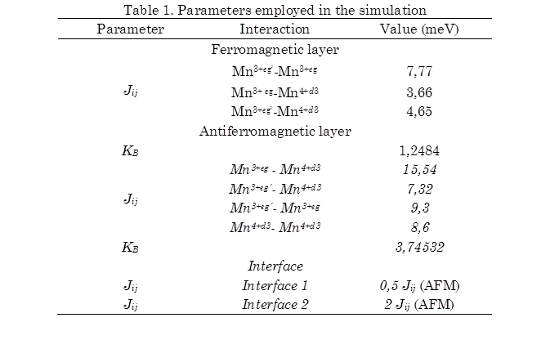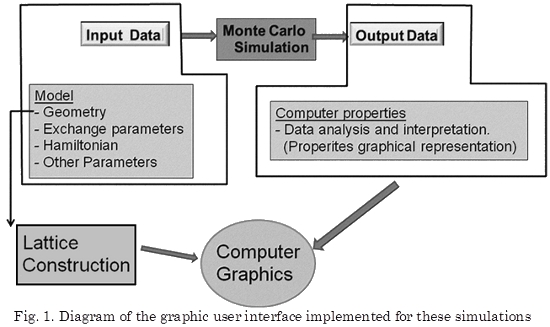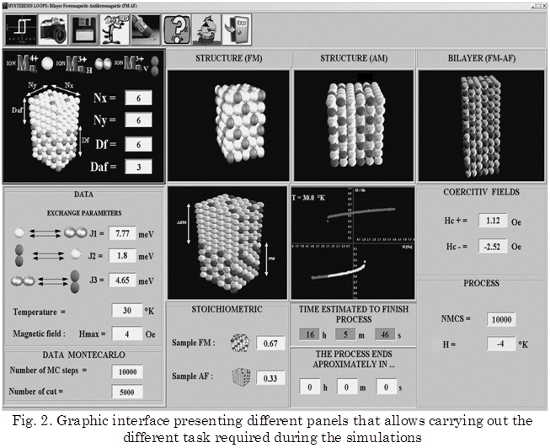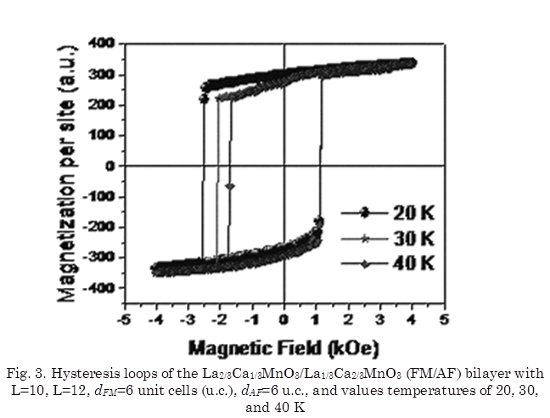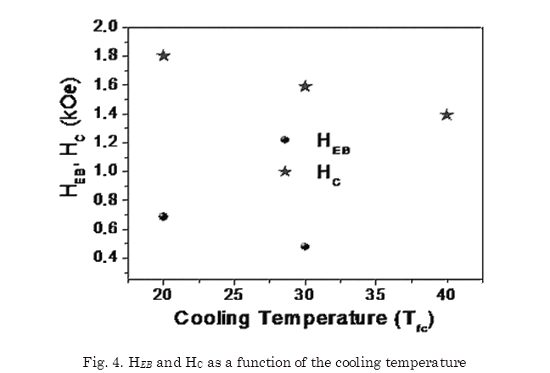Services on Demand
Journal
Article
Indicators
-
 Cited by SciELO
Cited by SciELO -
 Access statistics
Access statistics
Related links
-
 Cited by Google
Cited by Google -
 Similars in
SciELO
Similars in
SciELO -
 Similars in Google
Similars in Google
Share
TecnoLógicas
Print version ISSN 0123-7799On-line version ISSN 2256-5337
TecnoL. no.26 Medellín Jan./June 2011
Artículo de Investigación/Research Article
Graphic User Interface for Monte Carlo Simulation of Ferromagnetic/Antiferromagnetic Manganite Bilayers
Hector Barco-Ríos1, Edilberto Rojas-Calderón2, Elisabeth Restrepo-Parra3
1Departamento de Física y Química, Universidad Nacional de Colombia Sede Manizales, Manizales-Colombia, hsbarcor@unal.edu.co
2Departamento de Física y Química, Universidad Nacional de Colombia Sede Manizales, Manizales-Colombia, erojasca@unal.edu.co
3Departamento de Física y Química, Universidad Nacional de Colombia Sede Manizales, Manizales-Colombia, erestrepopa@unal.edu.co
Fecha de recepción: 04 de febrero de 2011 / Fecha de aceptación: 14 de julio de 2011
Abstract
The manganites have been widely studied because of their important properties as colossal magnetoresistance and exchange bias that are important phenomena used in many technological applications. For this reason, in this work, a study of the exchange bias effect present in La2/3Ca1/3MnO3/La1/3Ca2/3MnO3. This study was carried out by using the Monte Carlo method and the Metropolis Algorithm. In order to make easy this study, a graphic user interface was built alloying a friendly interaction. The interface permits to control the thickness of Ferromagnetic and Antiferromagnetic layer, temperatures the magnetic field, the number of Monte Carlo steps and the exchange parameters. Results obtained reflected the influence of all of these parameters on the exchange bias and coercive fields.
Keywords: Bilayers, exchange bias, graphic interface, manganites.
Resumen
Las manganitas han sido ampliamente estudiadas debido a sus propiedades importantes tales como magnetorresistencia colosal y polarización de intercambio, que son fenómenos importantes empleados en diversas aplicaciones tecnológicas. Por esta razón, en este trabajo se presenta el estudio del efecto de la polarización de intercambio (exchange bias) para el caso de bicapas de La2/3Ca1/3MnO3/La1/3Ca2/3MnO3. Este estudio se llevó a cabo empleando el método de Monte Carlo junto con el algoritmo de Metropolis. Con el fin de que este estudio sea más fácil, se construyó una interface gráfica para hacer más amigable la interacción con el usuario. La interface permite el control de parámetros como el espesor de la película, la temperatura, el campo magnético el número de pasos de Monte Carlo y los parámetros de intercambio. Los resultados obtenidos reflejaron la influencia de todos estos parámetros sobre el Exchange bias y el campo coercitivo.
Palabras clave: Bicapas, polarización de Intercambio, interfaz gráfica, manganitas.
1. Introduction
Graphical tools used for material structures studies and their physical properties are an important topic for simulating the matter at the atomic scale. It has played a very important role computer-aided modeling (Leach, 1996; Kokalj, 2003). Normally the simulations have large codes, and only the expert or the person who builds the code can use it. In the case of magnetic properties, there are many reports about modeling and simulations of properties and phenomena as magnetization, susceptibility, magnetoresistance hysteresis loops and exchange bias (Dagotto et al., 2001; Mazo-Zuluaga et al., 2007; Riaño-Rojas et al., 2009), nevertheless, is not usually to find reports of graphic user interfaces that make easy the calculation of magnetic properties.
In the case of the exchange bias phenomenon, it has been widely studied in the last years, because of its physical phenomenology that attracts the interest of the scientific community and its technological applications in spintronics devices (Gredig et al., 2002; Negulescu, 2003). This phenomenon is present in many materials as magnetites and manganites (Carvallo et al., 2003; García-Hernández et al., 2003; Nurgaliev, 2008). Manganites like La1-xCaxMnO3 have exhibited physical properties as tunneling; Magnetoresistance and fascinating electrical and magnetic properties (Gongqi et al., 2007). The aim of this work is to build a graphic user interface for carrying out exchange bias phenomenon simulations. The simulations were done by using the Monte Carlo method combined with the metropolis algorithm and Heisenberg Model.
2. Model description
The Manganites as Re2/3A1/3MnO3 (Re=La, Nd, Pr and A=Ca, Sr, Ba) are ferromagnetic compounds below Curie temperature (Tc) K (Huhtinen et al., 2002; Miller et al., 2006). They are formed by three types of ions: Mn4+ (S=3/2) bonded with A2+ ions and Mn3+eg´ and Mn3+eg´ (S=2) related to Re3+. These materials have simple cubic lattice with perovskite type structure and a coordination number of six (Dagotto, 2002). The Hamiltonian used for carrying out the simulations is given by (1) (Restrepo-Parra et al., 2009):

The first sum runs over nearest magnetic neighbors with a coordination number of six. The second term gives the core cubic magnetocrystalline anisotropy and the unit vector â indicates the easy axis direction. The third term in (1) represents the influence of the external magnetic field, being ĥ the direction of the magnetic field. For the simulation, three types of bond are considered: Mn3+eg’-O- Mn3+eg, Mn3+ eg-O-Mn4+d3 y Mn3+eg’-O-Mn4+d3 with exchange parameters depending on the type of manganite that is going to be simulated. These parameters are presented in Table 1. It is notable that values are different for the Ferromagnetic (FM), Antiferromagnetic (AF) layers and the interface. At the interface, the model proposed by Kiwi et al. (1999; 2000) was used. This model alternates two different interactions at the interface. These two interactions depend on the antiferromagnetic exchange parameters as is shown in Table 1.
Monte Carlo is a numerical method very useful for solving physical-statistical problems. The idea is to simulate randomly thermal fluctuations of the system, crossing from one state to another by means of Markov chains of the configurations space. For finding the probabilistic distribution, the system in the real case, meaning in thermodynamic equilibrium has to be simulated. For thin films, the Boltzmann distribution was used (Dagotto, 2002; Landau & Binder, 2009).
The graphic user interface consists of three main modules (see Fig. 1): (1) input and processing of initial data (2) numerical solution of the Hamiltonian; and (3) processing of the calculation results. Fig. 1 shows a diagram of graphic user interface including the processes carried out. Initially, to input data as the sample size and thickness is needed for building the lattice with its specific geometric. The exchange parameters and other data as temperature, magnetic field range and number of Monte Carlo steps are entered. With these data, the system energy is calculated by using the Hamiltonian implemented. Then, the Monte Carlo process begins to run. When this process ends, results are observed in the graphic interface, for their analysis and interpretation.
Currently the graphic user interface runs under Windows 9X, NT, 2000, Windows XP, Windows Vista and Windows 7. Memory requirements are quite modest for small runs (5 MB for typical calculation using 104 Monte Carlo Steps and 1000 particles), Files containing summary of calculation results are in ASCII format. Files containing for coordinates and magnetic properties of samples may be saved both in ASCII text and as binary.
3. Results and discussion
The Fig. 2 shows the user graphic interface implemented for the simulations. This interface contains different parts needed in the process. The upper part consists of several buttons that allow carrying out process as begin the program, capture, save, clean, help and exit. At the upper left corner, the sample construction is observed, with its corresponding geometry and configuration. Lower left panel contains data input as exchange parameters, temperature, magnetic field and number of Monte Carlo steps.
The upper right panel contains the bilayer construction while the central upper region shows the FM and AF layers configuration. The central panel presents the graphic resulting from the simulations, the lower central panel allows to observe the films stoichiometry, the time that the simulation will take and the number of Monte Carlo steps that have gone by. Finally, the right lower panel presents some measurements as right and left coercive fields.
The Fig. 3 shows some results obtained from the simulations. In this figure, hysteresis loops of a La2/3Ca1/3MnO3/La1/3Ca2/3MnO3 (FM/AF) bilayer can be observed. The simulations were done with samples size L=12, FM layer thickness dFM=6 unit cells (u.c.), AF layer thickness dAF=6 u.c., with temperatures values of 20, 30 and 40 K. The shifting toward the negative direction of the magnetic field is observed. The HEB and Hc fields can be calculated by means of (2) and (3):


Being Hleft and Hright are the hysteresis loops intercepts with the horizontal axis. Special characteristics were observed. As the temperature increases, the exchange bias and coercive field tend to decrease. The literature reports dependence between the HEB and the cooling temperature given by (4) (Moutis et al., 2002; Hu et al., 2004):

T0 represents the energy barrier for the thermal activation and H0 is the highest Exchange bias reached by the system.
The Fig. 4 shows the tendency of HEB and HC as a function of the temperature. In both cases, these parameters tend to decrease. The diminution in the HEB is due to the competition between the energy provided by the torque exerted by the AF layer on the FM layer, producing a spins pinning at the interface (causing the shifting) and the energy provided by the temperature, which promotes the spins disorder. HC also is strongly influenced by the temperature. The coercive field is the external magnetic field needed for producing a magnetization equal to zero. This field decreases as the temperature increases, because the competition between them.
4. Conclusions
A graphic user interface for simulating magnetic properties as exchange bias in FM/AF bilayers, using the Monte Carlo, metropolis algorithm and Heisenberg model was developed. This graphic interface allows having an easy interaction between the program and user. The Program was used for simulating La2/3Ca1/3MnO3/La1/3Ca2/3MnO3 (FM/AF) bilayers, observing results in agreement with those reported in the literature. For example, a diminution not only of the HEB but also Hc can be observed.
5. Acknowledgments
This work was supported by Direccion Nacional de Investigaciones of Universidad Nacional de Colombia Sede Manizales through the project No.10719.
Referencias
Carvallo, C., Muxworth, A.R., Dunlop, D., Williams, J.W., (2003); Micromagnetic modeling of first-order reversal curve (FORC) diagrams for single-domain and pseudo-single-domain magnetite, Earth Planet Sci. Lett., 213, 375-390. [ Links ]
Dagotto, E., Hotta, T., Moreo, A., (2001); Colossal magnetoresistant materials: the key role of phase separation, Physics Report, 344, 1-153. [ Links ]
Dagotto, E., (2002); Nanoscale Phase Separaton and colosal Magnetoresistance, 1ª edition, Springer, 1-4, 23, Berlin, Germany. [ Links ]
García-Hernández, M., de Andrés, A., Martínez, J.L., Sánchez-Soria, D., Martín-Carrón, L., Taboada, S., (2003); Transport properties and magnetoresistance of La-Ca manganites near the optimal doping concentrations, J. Solid State Chem., 171, 76-83. [ Links ]
Gongqi, Y., Songliu, Y., Guangming, R., Juhong, I., Xun X., (2007); Electrical and Magnetic Properties of Bilayer Manganites, J. Rare Earths, 25, 439-443. [ Links ]
Gredig, T., Krivorotov, I.N., Eames, P., Dahlberg, E.D., (2002); Unidirectional coercivity enhancement in exchange-biased Co/CoO, Appl. Phys. Lett., 81, 1270-1272. [ Links ]
Hu, J.G., Jin, G., Hu, A., Ma, Y.Q., (2004); Temperature dependence of exchange bias and coercivity in (Ga,Mn)As-MnO bilayer structures, Eur. Phys. J. B., 40, 265-271. [ Links ]
Huhtinen, H., Laiho, R., Lisunov, K.G., Stamov, V.N., Zakhvalinskii, V.S., (2002); Critical behavior of magnetoresistance near the metal-insulator transition of La0.7Ca0.3MnO3, J. Magn. Magn. Mater., 238, 160-167. [ Links ]
Kiwi, M., Mejia-López, J., Portugal, R.D., Ramírez, R., (1999); Exchange-bias system with compensated interfaces, App. Phys. Lett., 75, 3995-3997. [ Links ]
Kiwi, M., Mejía-López, J., Portugal, R.D. & Ramírez, R., (2000); Positive exchange bias model: Fe/FeF2 and Fe/MnF2 bilayers, Solid State Comm., 116, 315-319. [ Links ]
Kokalj, A., (2003); Computer graphics and graphical user interfaces as tools in simulations of matter at the atomic scale, Computational Materials Science, 28, 155-168. [ Links ]
Landau, D.P., Binder, K., (2009); A guide to Monte Carlo simulations in statistical physics, Third edition, Cambridge University Press, Cambridge, U.K. [ Links ]
Leach, A.R., (1996); Molecular modelling: Principles and applications, Addison Wesley Longman Limited, Edinburgh, England, 33-35. [ Links ]
Mazo-Zuluaga, J., Restrepo, J., Mejía-López, J., (2007); Surface anisotropy of a Fe3O4 nanoparticle: A simulation approach, Phys. B: Condens. Matter, 398, 187-190. [ Links ]
Miller, R.I., et al., (2006); Low-energy spin-polarized radioactive beams as a nano-scale probe of matter, Physica B: Conden. Matter, 374-375, 30-33. [ Links ]
Moutis, N., Christides, C., Panagiotopoulosa, I., Niarchos, D., (2002); On the temperature dependence of coercivity and exchange biasing field in La-Ca-Mn-O ferromagnetic/antiferromagnetic multilayers, J. Magn. Magn. Mater., 242-245, 544-546. [ Links ]
Negulescu, T.L., (2003); Metastable antiferromagnetic domain configurations in exchange biased bilayers, J. Appl. Phys., 93, 8606-8608. [ Links ]
Nurgaliev, T., (2008); Numerical investigation of the surface impedance of ferromagnetic manganite thin films, J. Magn. Magn. Mater., 320, 304-311. [ Links ]
Restrepo-Parra, E., Restrepo, J., Jurado, J.F., Vargas-Hernandez, C., Riaño-Rojas J.C., (2009); Monte Carlo simulation of the FM layer thickness influence on the exchange bias in FM/AFM bilayers, IEEE Trans. Magn., 45, 5180-5183. [ Links ]
Riaño-Rojas, J.C., Restrepo-Parra, E., Orozco-Hernández, G., Restrepo, J., Jurado, J.F., Vargas-Hernández, C., (2009); Geometry influence on the hysteresis loops behavior in La2/3Ca1/3MnO3 nanoparticles, Monte Carlo Simulation on a Heinsenberg-like model, IEEE Trans. Magn., 45, 5196-5199. [ Links ]













